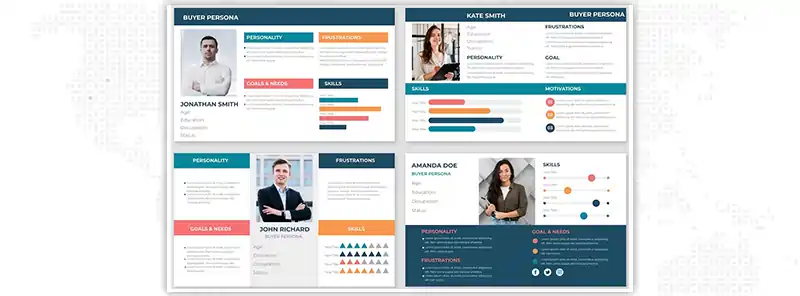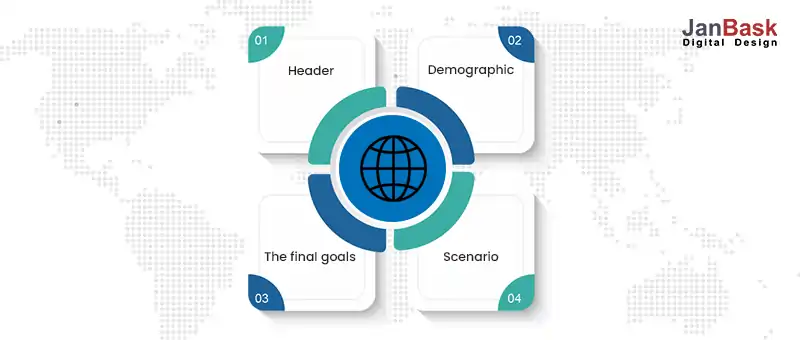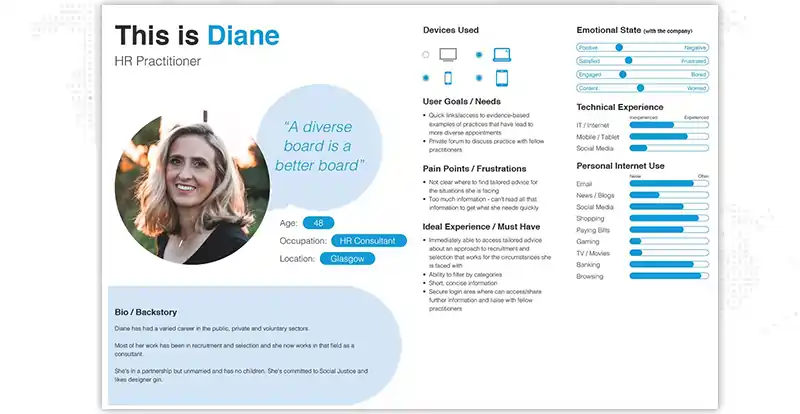
It is impossible to successfully promote a product if one does not first determine their target audience and what their target audience wants. You'll simply base your judgments on your assumptions about what people want. That can't be maintained over the course of any company's existence. Because of this, any firm that has the ambition to expand should prioritize the development of user personas.
Determining the ideal customers for your company to reach via the Internet can be challenging. Conversations with end users can be time-consuming, frustrating, and even misleading at some points in the conversation. The question now is, how can you ensure that your site is optimized for the visitors you intend to attract?
Developing a persona or a fictitious user whose characteristics are derived from those of your target audience is a good strategy that can be utilized.
56% of businesses have seen an increase in the quality of their leads because of user personas.
However, for a user persona to pay dividends for your company, it needs to be constructed in a manner that is authentic to your intended audience and effective enough that your persona helps actuate the website design process rather than merely becoming an afterthought.
Don't know where to begin and how to create user personas?
Keep reading to learn what is a user persona, how to create a persona, and how professional website design services can help you.

Looking to Create a User Persona For Your Website?
User personas are fictional representations of the types of customers you want to attract. Conducting user research will be the first step in the design process for you as a UX designer. This will allow you to develop empathy for your target users and determine exactly what they require from the product you're making for them. User research usually provides the foundation for developing a persona, including the target audience's requirements, objectives, and observable behavior patterns.
Not only will the research that goes into developing a user persona report also assist you in better understanding your target demographic, but it will also assist you in developing a superior product for that demographic.

Especially when it comes to matters pertaining to marketing choices, the manner in which you provide service to these consumers in the future will be determined by factors such as their age, level of education, life goals, and common concerns.
Even seemingly little aspects, such as a person's location or pay, can significantly impact the decisions they make and, as a result, how they use your product.
It is critical to understand the target audience when creating a product, whether it be an app for a smartphone or a website responsive to mobile devices. Understanding your users and their demands is the first step in formulating a well-defined problem statement that will guide you toward a solution to a genuine issue they are facing.
When you understand your target market better, you will be better able to select the features and design components that will give your product the most value. By providing answers to the following questions, a user persona elucidates the demographics of your target audience:
It is essential for a successful product development process to have a solid understanding of the requirements of your users. You can effectively discover and express user needs if you have well-defined user personas. Your value proposition relies heavily on your ability to accurately represent the people who use your product, and user personas can assist you in doing so.
Personas helped improve lead generation for 24% of businesses.
User personas are a useful tool for planning intelligent design decisions. They assist the product team in remembering real users, which in turn helps them focus their efforts and develop empathy for those users.
The following is a list of some of the benefits of creating user personas in the process of designing user experiences:
If designers want to create something beneficial for the people who will utilize it, empathy must be a central value in their work. User personas enable designers to develop understanding and sympathy for those who will ultimately utilize their products.
Because of the user personas, designers can:
The process of developing user personas can assist designers in stepping outside of themselves and recognizing the fact that various people have varying requirements and goals in life. Designers may be better able to deduce what the needs of real people could be if they consider the requirements of a fictional user persona first.
Identify the person or people for whom they are designing. Designers will likely to consider the user personas during the design process and want to build the best product possible for those users if they engage with the user personas and view them as real individuals for a greater time.
User personas are extremely helpful to designers in the process of formulating product strategies and accompanying usability testing sessions. It is possible to determine who a product is being built for and what features are important or superfluous for the target audience by gaining an in-depth understanding of user behavior and requirements from a user-centered design perspective.
The product team can prioritize feature requests depending on how effectively they meet the demands of a buyer persona image. Additionally, they can assist in mediating disagreements on design choices.
Most design work is done in multidisciplinary teams, which typically include persons with various areas of expertise, levels of experience, and perspectives. Every team member should be on the same page concerning the many design choices. The most important information about users is condensed into personas and presented in a manner that allows all members of the team and other stakeholders to comprehend and empathize with the information.
If you are new to this, taking the help of professional website design services can give you a kickstart.
A well-defined user persona will have the following four critical pieces of information:

Conduct significant research to ensure that the user personas you design represent the people using your product. After you have collected sufficient qualitative and quantitative data, you should organize the data into persona groups that represent your ideal consumers. Always remember that the primary requirements of the most essential user groups should be your first concern; you can't and shouldn't try to satisfy everyone's requirements.
Once you have your user groups, you can transform them into user personas using the information you gathered.
It is not difficult to choose a group of persona traits and name the resulting persona representation. Yet, it is challenging to construct user personas that are valuable tools for design and communication.
The following is a list of qualities that define a good user persona:
The header has a made-up name, an image, and a phrase that sums up what is most important to the persona in relation to your product. These elements help improve memorability and keep your design team focused on the consumers for whom they are producing the product they are designing.
This first stage may be straightforward, but including these persona characteristics will ensure that your persona is remembered and help the design team focus on the target audience for their creations.

Although the name and image may be made up, the demographic information is accurate and was derived from research on previous users. The personal background, the professional background, the user environment, and the psychographic sections comprise the primary sections of the demographic profile.
Personal history and context
The individual's age, gender, race, level of education, persona group, and family status are included in the personal background.
The professional history comprises information such as the occupation, the degree of income, and the amount of work experience.
The user environment encompasses the user's physical, social, and technological surroundings. This section aims to answer questions such as "What technical gadgets are available to users?" Where do they typically spend most of their time—a home office or a corporate office? And how frequently do they work with people from different organizations?
Developing a psychographic profile enables you to understand the motivations behind your user's actions, including the reasons they use your product.
The ultimate aim is the driving force that gets people moving and answers the question, what do users want or need to achieve by using your product? The end objectives of your users are the primary forces that drive them, and they determine what the user persona desires or requires to accomplish.
A scenario is a "day-in-the-life" story that illustrates how a user persona would engage with your product in a certain situation in order to reach his or her ultimate goal. Scenarios are used in user experience design. In most cases, the situation determines when, where, and how the narrative unfolds. Use cases are often written from the point of view of the user persona being portrayed, and they explain potential occurrences of use cases in the future.
If this is your first time developing user persona guidelines, we recommend developing a persona for each of your most important customer segments. The majority of available web designing services suggest developing between three and five unique identities, and we agree with this recommendation.
Keep in mind that you should stick to a minimum of 3-5 user personas. It will be difficult to achieve a higher figure than that. Having fewer identities will significantly reduce the size of your audience.
Adding a lot of secondary information to a user persona guide can be done in a straightforward manner by including well-known products in the guide.
A customer journey map could be useful if you have difficulty creating user personas for your website. This presents a wonderful opportunity for you to examine the consumer's path from a different perspective, and we hope you will emerge on the other side with improved insights.
If not, you can leverage web design services to get started.
Icons and illustrations are two types of visual content that particularly appeal to me when used in infographics. You can add context and information quite well with these itty-bitty visual aids. Icons are also easily recognizable by most individuals, eliminating the need for a steep learning curve.
Because of this, they can also be utilized as a user persona guide to convey a difficult notion or subject.
When performing an analysis of your various user personas, you should have at least one measure in common with each of them. In the event that this is not the case, you will be comparing extremely intangible aspects, such as their bio, keywords, or some other textual statistic.

Something universally compatible, such as a score or point total, can be compared across the board.
Consistency is essential when developing an effective user persona since it paves the way for easy comparisons. People wandering around aimlessly looking for information because the designer wants to change things up is not an efficient use of resources.
If you want to take your persona guide to the next level, one wonderful method to do so is by including real statistics and analytics. However, ensure that the information you deliver is relevant and easy to remember.
You can accomplish this by developing data visualizations. Remember, the aesthetic designers create should be kept simple because they combine crucial information with recognizable iconography.
Utilize a professional web design service if you do not have much experience (or any experience at all) in creating data visualizations.
36% of businesses have been able to shorten their sales cycles by adopting personas.
People of varying backgrounds come with their own unique sets of priorities, challenges, and preferences. It can be important to highlight the contrasts between your personas to assist in keeping your marketing efforts divided, and your product features focused.
Use design aspects that are unique to each user persona to create guides that are easier to remember and more comprehensively cover their needs. Consider how you can utilize design to reflect the ages of the people, their occupations, and their hobbies.
When you begin the real study of specific persona elements, it is essential to consider both the personas' goals and the pain points they experience.
Researching your users' pain issues and motives in depth is necessary if you want to construct an appropriate user persona that accurately represents your people.
It goes without saying that the objectives on which your product or service has a direct bearing need to be incorporated into each user persona trait. However, you should also go a step further and emphasize the different ambitions that this character might have.
Perhaps your product is an agency that specializes in content marketing. You can help users reach their indirect goals by providing solutions for them to use, as shown in the following example: Even if it is not something that your product can change or affect, it is still crucial to understand the persona traits because of the information it provides.
Including a backstory for the user character is essential to developing a complete user persona. It doesn't have to be a lot, but it should be enough to assist in highlighting the important characteristics or elements.
You can use this introduction to discuss the motivations behind your personas. Explain why this persona trait should matter to your firm.
Your user persona does not have to take the form of a document or a poster in accordance with any guidelines. To tell you the truth, it might be anything that assists your brand in developing superior experiences for your users.
Things like geography and pay are incredibly helpful considerations, particularly if most of your business comes from a single geographic region. Consider how different the people who live in one place are from those who live in other areas.
If you choose to neglect such significant factors, the time and work you put into developing your identity guide will be for naught.
It is 58% more successful to target cold leads with persona-based content as opposed to warm leads when you are targeting them without utilizing persona-based content.
In general, it is to your advantage to have a user persona guide that is as specific as possible. Take a look at the prior advice to get an idea of some of these tangible factors. However, a little more gray area helps better identify other areas or features.
It is possible to improve the effectiveness of the entire process of creating user personas by thinking of these personas as genuine customers or people. Because of this, we think that it is absolutely necessary to provide them with a legitimate name.
Visualizing what a typical day in the life of your character would be like can be a useful exercise for getting into character. Consider that utilizing a timeline infographic is a simple method that may be used to represent a daily or weekly activity. You can use icons to show the many activities they participate in or the challenges they face.
When developing your marketing strategy, it might be helpful to examine the ways in which your user personas are similar to and different from one another. Displaying your characters on a single sheet dedicated to comparison can make comparison much simpler.
What are the motivating factors behind each of your user personas? Try to distill all that information into a few punchy keywords. Not only do they have a distinct visual quality, but they may also be displayed as posters all throughout the workplace. These guides will also provide you with all the information you require concerning each character by using only a few keywords.
It is imperative that the social media platform or other forms of technology that a character employs on a regular basis be detailed in each guide. This advice, along with the user persona trait, is extremely helpful for any brand or business that operates mostly online.
Because all your hard work would be wasted if you targeted one of these personas on the incorrect device or platform, understanding both of those factors may mean difficulty right from the start.
Take the time to find out where your personas are hanging out and what device they use to do so, and then utilize that information to target your marketing efforts better.
You should provide each user persona a true name, as was previously discussed, and the same thing can be said when it comes to employing photographs or headshots of the personas. Because it is essential to give the idea that this is a real person, you shouldn't choose famous persons, people from your office, or easily recognized faces. Because of this, people will unconsciously incorporate the characteristics of these other people into their identities.
When used to target cold leads, content based on user personas results in an almost sixfold increase in consumer interaction.
The most accurate user personas are based on real-world research conducted in the field, resulting from extensive user interviews and observational data collected from genuine customers. It is of the utmost importance to gather as much information and knowledge about users as is humanly possible by conducting interviews with and/or watching a sufficient number of people who represent a target audience. When a researcher participates in these interviews, the more information they notice and record, the more realistic the character will be.
During this stage, it is essential to avoid creating user personas that represent stereotypical users. These are users whose experiences bear little resemblance to those of actual users. Wholly fictitious stories involve imaginary individuals based on very little or no research, add absolutely nothing of value to the design process, and, in fact, can make things worse. In addition, this method's trustworthiness might be readily questioned if the user personas are not developed properly.
The findings of the research will be analyzed in the following stage. During this stage of the process, the objective is to identify patterns in the user research data that will make it able to classify consumers according to the characteristics that they share:
It is essential for the stakeholders to engage in persona socialization to get the design team closer to action. Every member of the team and any stakeholders involved should have a good association with the personalities and recognize the value they bring. As more and more people learn about the personas, they begin to talk about them as if they were real individuals. A persona that has been carefully crafted can feel like it's another member of the team.
Product Managers should come up with a fictitious name for their User persona because a User Persona represents a collection of users whose behaviors are similar to one another. Ensure that the name won't cause any confusion among the stakeholders who will be viewing our User Persona.
Including a job title in your user persona will be of even greater assistance to us. For instance, if college students make up the bulk of our target audience, we should designate "college student" as the job title of our user persona.
Personas are created at a rate that is two times more likely in businesses that meet or surpass their lead and revenue targets than in businesses that fall short of these goals.
In contrast to the aspect that came before it, frustrations are items that get in the way of people accomplishing their objectives. Because of this, it is imperative that we put the frustrations of our consumers first in order to guarantee that their issues will be resolved.
Product Managers are responsible for filling in this section with information regarding the preferred channels of their users. Do people feel more at ease receiving advertisements via email, social media, or even traditional forms of advertising? Everything hinges on the kind of persona we end up creating.
We can also include the brands that are used the most by them. The use of other brands can help a comparison of your product to those of its competitors.
The quote from the user should be condensed into one or two phrases. The quotation needs to be representative of our user persona in its entirety.
Although it's easy to ignore, it's crucial to your website's design that your user persona accurately reflects your target demographic regarding age. If your persona suggests that your audience has a lower average age, your website may be better served by a more modern and up-to-date theme.
If your website is over a few years old, building it with simplicity rather than style might make more sense. Outside of the general appearance of your website, having a user persona that includes an age will allow you to more accurately target your marketing efforts and produce more effective text that is more specifically customized to the consumer.
It is vitally necessary to comprehend the educational level of one's target audience and incorporate this information into a user persona for several different explanations. If you put this information in a persona, it will assist you in choosing the kind of word choice that you should use in your text.
When it comes to the navigation button copy, this is of the utmost importance. Suppose your persona has a hard time understanding what a certain navigational button, or even worse, a call-to-action, means. In that case, your website will have a lot of trouble getting users to navigate to the location where you want them to go.
Understanding the different platforms your users are accessing the internet through is essential to developing a good user persona for your website. For instance, having a mobile-friendly site that renders correctly and rapidly for people connecting from Mac goods makes sense if you have a persona who exclusively uses Mac products and relies heavily on an iOS device. Including this information in a persona can help you tailor the site's UX to the platforms your target audience is most likely to use when they visit, reducing the likelihood that they will leave because of a poor experience.
Because each user persona is often limited to a single page, you will need to concentrate on the most important aspects. As a general rule, you should refrain from adding unnecessary details that cannot be utilized to affect the design. Omit it if it does not impact the final design and does not help make any decisions any simpler.
Personas are also essential for locating your ideal customers in the real world, which enables you to test and verify your product with actual customers. Therefore, you should ensure that each character is detailed and accurate, avoid making them into overly simplified caricatures, and give enough information to discover a real-life depiction of each persona.
If you plan out these 36 characteristics for a user persona and then properly apply the information it provides you about your audience to how your business is designed, marketed, and developed online, then your company is assured to build an online presence that is properly optimized for the users who make up your target demographic.
When developing user personas, it is important to keep the context of the product you are building in mind at all times. While it is important to develop a real character, there is no reason to incorporate irrelevant specifics that won't make a difference in the character's overall look.
Do not become disheartened because these are likely to take some time and necessitate a large amount of research on your part. In the long run, they will be worthwhile because you will be able to assist your consumers more effectively.
If this is something that still confuses you or you need a headstart, you can start by working with our website design experts at JanBask Digital Design.
Looking For Website Designing Services?

1. What are user persona demographics?
A person's age, gender, race, and income bracket are all aspects of demographics; they are all rather fundamental characteristics. Personas, on the other hand, delves deeper into the characteristics of the buyer, concentrating on what makes them who they are and what motivates them to look for the services or products you provide.
2. What are the characteristics of a persona?
A persona is a fictional figure that exemplifies the qualities (sometimes called traits) of various customer groups that are significant to a particular business or group of businesses. In other words, these are the types of users or customers who represent, for example, the customer groups that are the most loyal or the most valuable (or the most desirable).
3. What characteristics define an effective user persona?
Personas represent a significant portion of your website's audience. Put into words and concentrate on the most important user groups' most urgent requirements and meet customer expectations and improve sales. Paint a clear image for the user of what they may expect from the site and how they will most likely utilize it.
4. What components make up a user persona?
User personas are semi-fictional characters based on your product's actual (or idealized) users. To enhance the marketing of your product, you can construct personas by conducting interviews with users and categorizing the responses based on a variety of demographic and psychographic factors.
E
Great suggestions on creating user persona. I am going to use them.
J
Thanks for your feedback!
W
These are very amazing tips on creating a buyer persona.
D
I have learnt a lot from your blog. Thanks for sharing.
C
Creating a user persona has helped improve revenue cycles for our brand. It definitely helps.
M
Great read! Amazing article and great suggestions.
D
Any tools you would suggest that can help analyze user persona and data better?